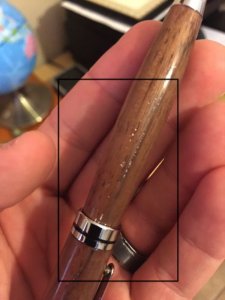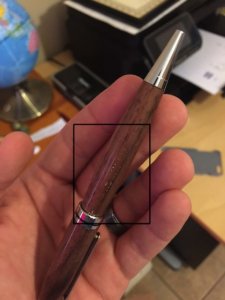Wolfeman46
Member
Hey all! Like the title says, I am having issues with white spots a few days after finishing, but only on two pens so far. It hasn't shown up on any others that I can see.
I am using the StickFast CA finishing kit. I was told yesterday by a friend that he doesn't use StickFast because it has a tendency to be too brittle. Is this what's happening? I tried to get a picture that shows the spots. It's the very first layer (or at least not the top layer) that has them.

View in Gallery

View in Gallery
My finishing process currently is:
1 After sanding through 1000 (I do 220, 320, 400, 500, 800, 1000 - at low speed and then also longitudinally).
2 I'll clean it off with a rag while spinning. Seems to work for me to get all the dust off without any stuff hanging around.
3 Next I'll do a layer of THIN CA and hit it with two quick sprays of accelerator.
4 I'll do a layer of MEDIUM CA and then hit it with accelerator also.
5 I'll repeat 4 about 3-5 times.
6 I'll use the StickFast Gloss finishing on the blank.
7 I'll let it dry for a few hours (sometimes...heh) and then assemble.
The pen shown is a walnut European style pen. It only showed up in the past few days and it was NOT wet-sanded. The pen was laying on a towel with about 10 other pens close to a window in a room that gets about 80-85 degrees during the day.
Is it something I'm doing wrong or should I be using a different brand?
I am using the StickFast CA finishing kit. I was told yesterday by a friend that he doesn't use StickFast because it has a tendency to be too brittle. Is this what's happening? I tried to get a picture that shows the spots. It's the very first layer (or at least not the top layer) that has them.

View in Gallery

View in Gallery
My finishing process currently is:
1 After sanding through 1000 (I do 220, 320, 400, 500, 800, 1000 - at low speed and then also longitudinally).
2 I'll clean it off with a rag while spinning. Seems to work for me to get all the dust off without any stuff hanging around.
3 Next I'll do a layer of THIN CA and hit it with two quick sprays of accelerator.
4 I'll do a layer of MEDIUM CA and then hit it with accelerator also.
5 I'll repeat 4 about 3-5 times.
6 I'll use the StickFast Gloss finishing on the blank.
7 I'll let it dry for a few hours (sometimes...heh) and then assemble.
The pen shown is a walnut European style pen. It only showed up in the past few days and it was NOT wet-sanded. The pen was laying on a towel with about 10 other pens close to a window in a room that gets about 80-85 degrees during the day.
Is it something I'm doing wrong or should I be using a different brand?
Last edited:





